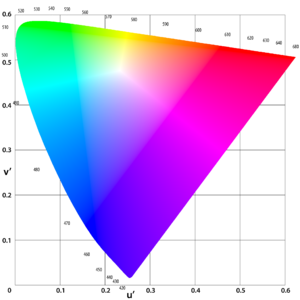CIELUV
In colorimetry, the CIE 1976 L*, u*, v* color space, commonly known by its abbreviation CIELUV, is a color space adopted by the International Commission on Illumination (CIE) in 1976, as a simple-to-compute transformation of the 1931 CIE XYZ color space, but which attempted perceptual uniformity. It is extensively used for applications such as computer graphics which deal with colored lights. Although additive mixtures of different colored lights will fall on a line in CIELUV's uniform chromaticity diagram (called the CIE 1976 UCS), such additive mixtures will not, contrary to popular belief, fall along a line in the CIELUV color space unless the mixtures are constant in lightness.
Historical background
CIELUV is an
CIELUV uses Judd-type (translational)
XYZ → CIELUV and CIELUV → XYZ conversions
By definition, 0 ≤ L* ≤ 100 .
The forward transformation
CIELUV is based on CIEUVW and is another attempt to define an encoding with uniformity in the perceptibility of color differences.[4] The non-linear relations for L*, u*, and v* are given below:[4]
The quantities u′n and v′n are the (u′, v′) chromaticity coordinates of a "specified white object" – which may be termed the
The reverse transformation

The transformation from (u′, v′) to (x, y) is:[6]
The transformation from CIELUV to XYZ is performed as follows:[6]
Cylindrical representation (CIELCh)
CIELChuv, or
The cylindrical version of CIELUV is known as CIELChuv, or CIELChuv, CIELCh(uv) or CIEHLCuv, where C*uv is the chroma and huv is the hue:[6]
where
Furthermore, the saturation correlate can be defined as
Similar correlates of chroma and hue, but not saturation, exist for CIELAB. See Colorfulness for more discussion on saturation.
Color and hue difference
The color difference can be calculated using the Euclidean distance of the (L*, u*, v*) coordinates.[6] It follows that a chromaticity distance of corresponds to the same ΔE*uv as a lightness difference of ΔL* = 1, in direct analogy to CIEUVW.
The Euclidean metric can also be used in CIELCh, with that component of ΔE*uv attributable to difference in hue as[4] ΔH* = √C*1C*2 2 sin (Δh/2), where Δh = h2 − h1.
See also
References
- .
- ^ Mark D. Fairchild, Color Appearance Models. Reading, MA: Addison-Wesley, 1998.
- ^ D. H. Alman, R. S. Berns, G. D. Snyder, and W. A. Larson, "Performance testing of color difference metrics using a color-tolerance dataset". Color Research and Application, 21:174–188 (1989).
- ^ ISBN 978-0-470-04904-4.
As 24/116 is not a simple ratio, in some publications the 6/29 ratio is used, in others the approximate value of 0.008856 (used in earlier editions of CIE 15). Similarly some authors prefer to use instead of 841/108 the expression (1/3)×(29/6)2 or the approximate value of 7.787, or instead of 16/116 the ratio 4/29.
- ^ Colorimetry, second edition: CIE publication 15.2. Vienna: Bureau Central CIE, 1986.
- ^ ISBN 1-55860-792-7.
- ISSN 1609-395X.
- .
- hdl:10419/101098.
External links
- Chromaticity diagrams, including the CIE 1931, CIE 1960, CIE 1976
- Colorlab MATLAB toolbox for color science computation and accurate color reproduction (by Jesus Malo and Maria Jose Luque, Universitat de Valencia). It includes CIE standard tristimulus colorimetry and transformations to a number of non-linear color appearance models (CIELAB, CIE CAM, etc.).








